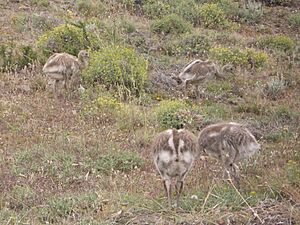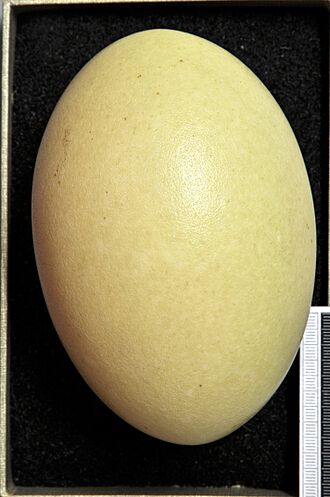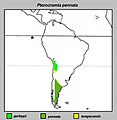Darwin's rhea facts for kids
Quick facts for kids Darwin's rhea |
|
|---|---|
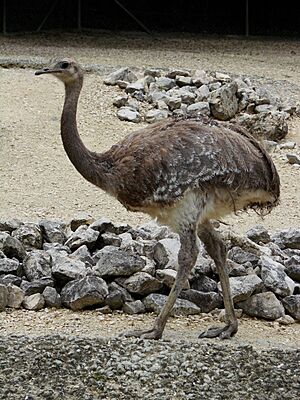 |
|
| At Zurich Zoo, Switzerland | |
| Conservation status | |
| Scientific classification | |
| Genus: |
Rhea
|
| Species: |
pennata
|
| Subspecies | |
|
|
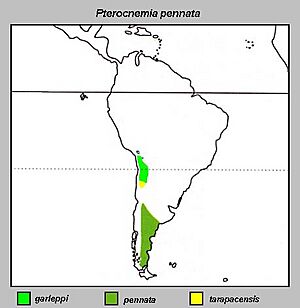 |
|
| Synonyms | |
|
|
The Darwin's rhea or lesser rhea (Rhea pennata) is a large bird that cannot fly. It is the smaller of the two types of rheas that are still alive today. You can find this bird in the high plains called the Altiplano and the Patagonia region of South America.
Contents
What Does the Darwin's Rhea Look Like?
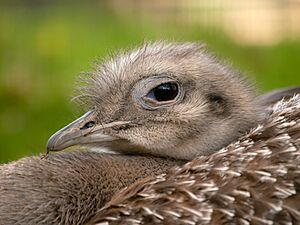
The lesser rhea usually stands about 90 to 100 centimeters (35 to 39 inches) tall. Its body length is about 92 to 100 centimeters (36 to 39 inches). These birds weigh between 15 and 28.6 kilograms (33 to 63 pounds).
Like most ratites (a group of flightless birds), the Darwin's rhea has a small head and a small bill. Its bill is about 6.2 to 9.2 centimeters (2.4 to 3.6 inches) long. However, it has long legs and a long neck. Its wings are larger than those of other ratites, which helps it run very fast. It can reach speeds of 60 kilometers per hour (37 miles per hour). This speed helps it escape from predators.
The rhea's toes have sharp claws, which are good for defense. Their feathers are like those of ostriches. They do not have a special part called an aftershaft. Their feathers are spotted brown and white. The upper part of their legs, called the tarsus, is covered in feathers. The tarsus is 28 to 32 centimeters (11 to 13 inches) long. It has 18 flat plates on the front.
Where Did Its Name Come From?
In Argentina, where most of these birds live, they are called ñandú petiso or ñandú del norte. Other names include suri and choique. The name ñandú comes from the greater rhea's name in the Guaraní language, ñandu guazu. This means "big spider." This name might come from how they open and lower their wings when they run.
In English, Darwin's rhea is named after Rhea, a Greek goddess. The word pennata means "winged." The specific name for this bird was given in 1834 by Alcide d'Orbigny. He was a scientist who lived at the same time as Charles Darwin. D'Orbigny was the first to describe this bird to Europeans. He found a specimen near the Río Negro in Argentina.
Until 2008, this bird was placed in its own group, or monotypic genus, called Pterocnemia. This word comes from two Greek words: pteron, meaning "feathers," and knēmē, meaning "leg." So, Pterocnemia means "feather-legged," because of the feathers on the top part of its legs. In 2008, the SACC decided to put Pterocnemia into the same group as the greater rhea, which is the genus Rhea.
Types of Darwin's Rheas
Scientists have traditionally recognized three types, or subspecies, of Darwin's rhea:
- R. p. garleppi lives in the high grasslands called puna in southeastern Peru, southwestern Bolivia, and northwestern Argentina.
- R. p. tarapacensis lives in the puna of northern Chile. This ranges from the Arica and Parinacota area to the Antofagasta area.
- R. p. pennata lives in the Patagonian steppes (grassy plains) of Argentina and Chile.
The IUCN (International Union for Conservation of Nature) now considers the first two northern types, R. p. tarapacensis and R. p. garleppi, as a separate species called the puna rhea (R. tarapacensis).
How Darwin's Rheas Behave
Darwin's rhea mainly eats plants, so it is a herbivore. Sometimes, it will eat small animals like lizards, beetles, or grasshoppers. They mostly eat saltbush plants and fruits from cacti. They also eat grasses, roots, seeds, and leaves.
These birds are usually quiet. However, chicks make a sad whistling sound. Males looking for a female make a loud booming call.
When males are sitting on eggs, they become very protective and can even be aggressive towards females. Because of this, females lay their later eggs near the nest, not inside it. The male then moves most of these eggs into the nest. Some eggs stay outside and rot, which attracts flies. The male and later the chicks eat these flies.
The eggs hatch after 30 to 44 days. A group of eggs, called a clutch, can have anywhere from 5 to 55 eggs. The eggs are 87 to 126 millimeters (3.4 to 5 inches) long and are greenish-yellow. Chicks become adults when they are about three years old.
When it's not breeding season, Darwin's rheas are quite social. They live in groups of 5 to 30 birds. These groups include both males and females of different ages.
Where Do Darwin's Rheas Live?
Darwin's rhea lives in open areas with scattered bushes. These areas include the grasslands of Patagonia and the high Andean plateau, known as the Altiplano. They are found in Argentina, Bolivia, Chile, and Peru. All types of Darwin's rheas prefer grasslands, areas with bushes, and marshlands.
However, the type found in Patagonia prefers lower elevations, usually below 1,500 meters (4,900 feet). The other types typically live at higher elevations, from 3,000 to 4,500 meters (9,800 to 14,800 feet). Sometimes, they can be found as low as 1,220 meters (4,000 feet) in the south.
How Darwin Discovered the Rhea
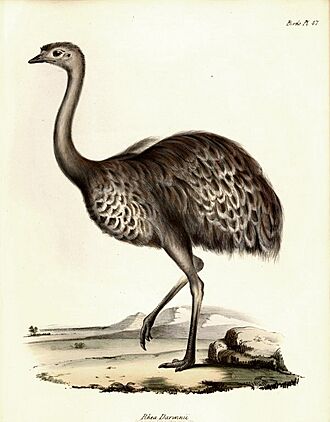
During the second voyage of HMS Beagle, a young scientist named Charles Darwin explored many places on land. Around August 1833, he heard from local cowboys, called gauchos, in northern Patagonia. They told him about a smaller rhea, which they called the "Avestruz Petise." This bird was said to be very rare.
Darwin searched for this bird without success. The Beagle then sailed south to Port Desire in southern Patagonia. On December 24, Darwin shot a guanaco (an animal similar to a llama) for their Christmas meal. In early January, the ship's artist, Conrad Martens, shot a rhea. They ate it before Darwin realized it was the small, rare rhea he had been looking for, not a young larger rhea. He quickly saved its head, neck, legs, one wing, and many large feathers. Like his other collections, these were sent to John Stevens Henslow in Cambridge, England.
On January 26, the Beagle entered the Straits of Magellan. At St Gregory's Bay, Darwin met local people from Patagonia. He called them "excellent practical naturalists." A man who was half-Native American told him that the smaller rheas were the only kind found that far south. The larger rheas stayed further north. On a trip up the Santa Cruz River, they saw several small rheas. However, these birds were too shy to get close to or catch.
In 1837, the bird scientist John Gould officially described Darwin's rhea. He named it Rhea darwinii. Later, this name was combined with R. pennata. Gould presented his findings to the Zoological Society of London. Darwin then read a paper about the eggs and where the two types of rheas lived.
When Gould said that Darwin's rhea and the greater rhea were different species, it caused a big question for Darwin. These birds mostly live in different parts of Patagonia, but there is an area where both species live together. At that time, many scientists believed that every living thing was created in a fixed form. They thought species could only change their appearance slightly to fit their environment, but they would always be the same species. But now, Darwin had two different species. This made him start to think that species were not fixed at all. He wondered if another process might be at work, which led to his ideas about evolution.
Protecting Darwin's Rhea
The IUCN lists Darwin's rhea as a species of "least concern". This means it is not currently in danger of disappearing. The type found in the south is still quite common and spread out. Its home range is about 859,000 square kilometers (332,000 square miles).
However, the situation for the two northern types is more worrying. Their total population might be as low as a few hundred birds. The IUCN now classifies these northern types as Rhea tarapacensis and considers them "near threatened". The main dangers to these birds are hunting, collecting their eggs, and their habitat being broken up. This happens when their land is turned into farms or pastures for cattle.
In Chile's Aysén Region, the Patagonia National Park has a special place called the Centro de Reproducción para la Conservación del Ñandú. This center helps to breed and protect Darwin's rhea. It is run by Tompkins Conservation with help from the National Forest Corporation.
Images for kids
See also
 In Spanish: Ñandú de Magallanes para niños
In Spanish: Ñandú de Magallanes para niños



